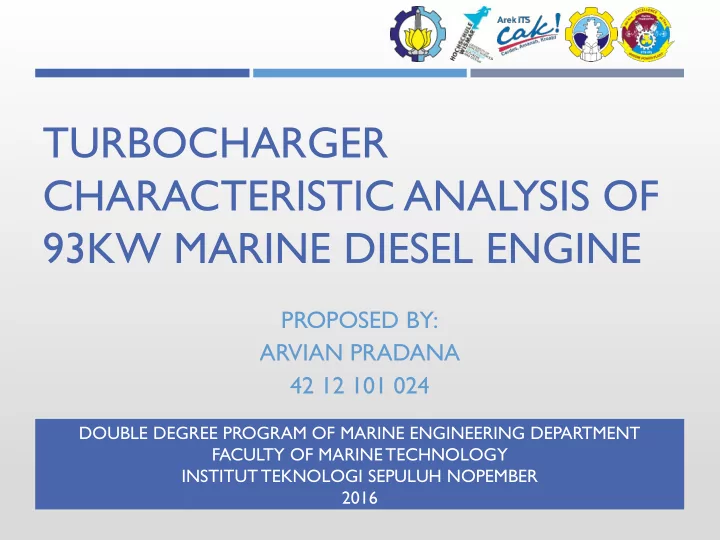

TURBOCHARGER CHARACTERISTIC ANALYSIS OF 93KW MARINE DIESEL ENGINE PROPOSED BY: ARVIAN PRADANA 42 12 101 024 DOUBLE DEGREE PROGRAM OF MARINE ENGINEERING DEPARTMENT FACULTY OF MARINE TECHNOLOGY INSTITUT TEKNOLOGI SEPULUH NOPEMBER 2016
OUTLINE Background Problem Formulation and Scope Methodology Discussion and Results Conclusions
BACKGROUND Fishing vessels with a size of 30 GT is under development Development carried out for fishing vessels are design, economical, and performance Improvement of engine performance can be done by installation of turbocharger The aim of its installation is to increase power output and efficiency engine Study of the results must be done for the further result
PROBLEM FORMULATION & SCOPE Problem Formulation How to select a turbocharger for marine diesel engine 1. with 93 kW of power output? How to match the engine with a turbocharger? 2. Scope of Problem The simulation using simulation modeling software 1. Simulation only used to find the performance of the engine which had been 2. installed by turbocharger The experiment will be done to compare the efficiency and performance of the 3. engine which had been installed by turbocharger with a different specification
METHODOLOGY FLOW CHART
DISCUSSION AND RESULTS
SIMULATION PROCESS USING SOFTWARE There are a few step of simulation process, as follows: Collecting data of engine flow and arrangement Enviroment input object Compressor object Intake valve object Cylinder object Exhaust valve object Injection system object Turbine object Cranktrain object
ENGINE DATA Engine Specification Data (designed by Juniono Raharjo, 2015) No. of Cylinder : 4 Displacement : 3.9 L Bore : 102 mm Stroke : 120 mm Inlet Valve : 45 mm (clearance = 0.25 mm) Outlet Valve : 43 mm (clearance = 0.51 mm) Compression Ratio : 16.5 : 1 Firing Order : 1-3-4-2
TURBOCHARGER I DATA
TURBOCHARGER I OUTPUT
TURBOCHARGER I OUTPUT Type of Device Compressor Turbine Speed [RPM] 178662 178662 Pressure Ratio (static) 2.48 2.48 Pressure Ratio 2.45 2.54 Mass Flow Rate [kg/s] 0.15 0.15 Power [kW] 21.1 23.6 Efficiency [%] 61.4 72.1 Inlet Pressure [bar] 0.94 3.01 Outlet Pressure [bar] 2.34 1.21 Inlet Temperature [K] 297 898 Outlet Temperature [K] 437 766 Map PR Exceeded/Stalled ? NO NO PR less than 1.0 ? NO NO Brake SFOC TORQUE RPM Power (g/kWh) (Nm) (kW) 2200 96.823 228.023 420.269
TURBOCHARGER II DATA
TURBOCHARGER I OUTPUT
TURBOCHARGER II OUTPUT Type of Device Compressor Turbine Speed [RPM] 165365 165365 Pressure Ratio (static) 2.38 2.41 Pressure Ratio 2.35 2.46 Mass Flow Rate [kg/s] 0.14 0.15 Power [kW] 16 22.1 Efficiency [%] 73.9 72 Inlet Pressure [bar] 0.95 2.89 Outlet Pressure [bar] 2.25 1.2 Inlet Temperature [K] 297 896 Outlet Temperature [K] 408 768 Map PR Exceeded/Stalled ? NO NO PR less than 1.0 ? NO NO Brake SFOC TORQUE RPM Power (g/kWh) (Nm) (kW) 2200 93.622 228.489 406.374
TURBOCHARGER III DATA
TURBOCHARGER I OUTPUT
TURBOCHARGER III OUTPUT Type of Device Compressor Turbine Speed [RPM] 194046 194046 Pressure Ratio (static) 1.43 1.82 Pressure Ratio 1.44 1.85 Mass Flow Rate [kg/s] 0.09 0.09 Power [kW] 6.2 8.9 Efficiency [%] 47.4 67.7 Inlet Pressure [bar] 0.97 1.97 Outlet Pressure [bar] 1.38 1.08 Inlet Temperature [K] 298 879 Outlet Temperature [K] 365 793 Map PR Exceeded/Stalled ? NO NO PR less than 1.0 ? NO NO Brake SFOC TORQUE RPM Power (g/kWh) (Nm) (kW) 2200 51.929 254.828 225.401
CONCLUSIONS 1. Turbocharger match results known from operating line turbocharger to the engine performance. From the first turbocharger (GT2052-3), maximum power output value is 96.823 kW at 2200 RPM. Obtained torque value by 420.269 Nm, with a specific fuel oil consumption by 228.02 g/kWh. The second turbocharger (GT2052-1), maximum power output value is 93.622 kW at 2200 RPM. Obtained torque value by 406.374 Nm, with a specific fuel oil consumption by 228.389 g/kWh. The third turbocharger (GT1241), maximum power output value is 51.929 kW at 2200 RPM. Obtained torque value by 225.401 Nm, with a specific fuel oil consumption by 254.828 g/kWh. Turbocharger can be considered match if the efficiency level turbocharger >80%. So turbocharger selected is GT2502-1 with highest efficiency at full load. 2. Maximum load of the engine at 2200 RPM installed with GT2502-1turbocharger, power generated value is 93.662 kW. Efficiency of the selected turbocharger compressor map is 73.933%, and turbine efficiency map 72.022%. Compressor and turbine revolution is at 165365 RPM. Boost pressure generated at highest point of this turbocharger used is 2.247 bar, with a temperature of 408.01 K.
REFERENCES Rautenberg M., Mobarak A., Molababic M. (1983) Influence of heat transfer between turbine and compressor on the performance of small turbochargers, JSME Paper 83- T okyo-IGTC-73, International Gas Turbine Congress. Jung M., Ford R.G., Glover K., Collings N., Christen U., Watts M.J. (2002) Parameterisation and Transient Validation of a Variable Geometry Turbocharger for Mean-Value Modelling at Low and Medium Speed-Load Points, SAE paper 2002-01-2729. Riegler C. (1999) Correlations to include heat transfer in gas turbine performance calculations, Aerospace T echnology 5, 281-292. Guzovic Z., Matijasevic B., Rusevljan M. (2001) Generalised Correlations for heat transfer determination in turbine cascades, StrojniskiVestnik. 47, 8. Keshaverzi Hamid. 2005. Selection and Matching Turbocharger to Large Propullsion Diesel Engine Performance. Ph.D Dissertation. Liverpool Jhon Moores University. TancrezM. 2010. Turbine Adapted Maps for Turbocharger Engine Matching. M.Sc Thesis. Universidad Politécnica de Valencia, Spain.
Recommend
More recommend